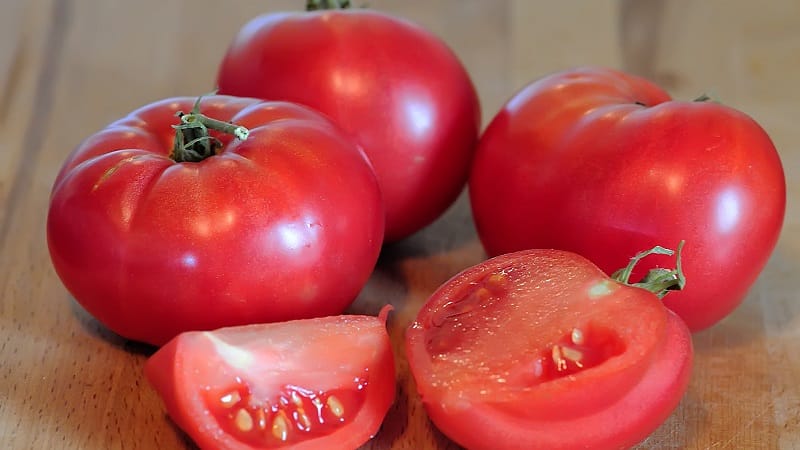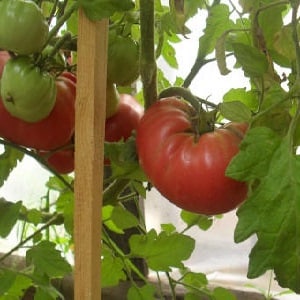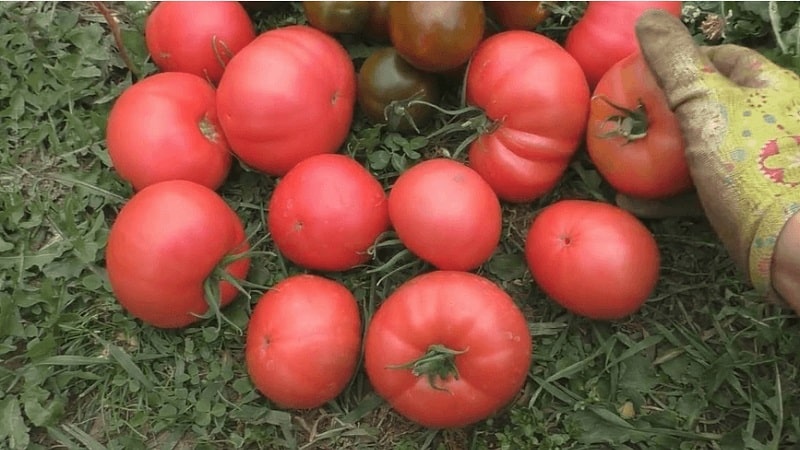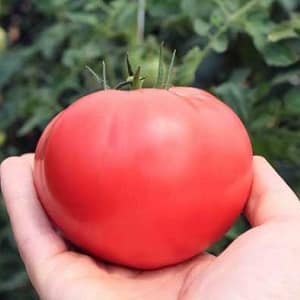A delicious salad tomato with a sweet honey taste - the “Pink Elephant” tomato and its other benefits
The Pink Elephant tomato is a real beauty. Tomatoes received an interesting name because of their size and color. This is an excellent variety for salads, with a balanced taste - sweet and sour. Ideal fresh - the flesh is tender and soft. Included in the top 50 best tomato varieties in Russia. Let's get to know him in more detail.
Description of the variety
The “Pink Elephant” tomato is a semi-determinate type of tomato created by Russian scientists in the late 90s of the last century and originally intended for cultivation in greenhouse conditions. However, many gardeners manage to reap good harvests by growing it in open ground.
Distinctive features
The variety is ideal for salads. But lovers of sweet and thick juices use these tomatoes to make them. Among its relatives, it is considered a delicacy, so it is not practical to make juices, pastes, or lecho from it. It is also important to remember that ripe fruits are not stored for a long time.
Fruit characteristics and yield
The fruits of the “Pink Elephant” variety have a slightly flattened shape and are bright pink in color.. The average weight of a tomato is 300 g, some of them reach 1000 g. The fruits are dense, fleshy, with a small number of seeds and thin skin. From one 1 m² you can harvest up to 8 kg of crop. You will be able to try them within 110 days after the seeds germinate.
Reference. Gardeners note average yields compared to other tomatoes, but choose “Pink Elephant” for its taste and presentable presentation, which allows the fruits to be successfully used for commercial purposes.
The photo speaks more than eloquently about this variety.:

How to grow seedlings
Another feature of the “Pink Elephant” is that it is grown only by seedlings. regardless of climatic conditions.
Seed preparation
Step-by-step steps for preparing seeds for planting are as follows::
- At the beginning of March, it is necessary to begin preparing seeds for seedlings in order to sow them in the second half of the month. In warm regions, seeds begin to be prepared earlier, and so are planted accordingly. To begin, treat the material purchased or prepared from the last harvest in a solution of potassium permanganate for about 30 minutes. We throw away the floating seeds; they will not sprout.
- After treating with potassium permanganate, rinse them under running water.
- Dry the resulting seeds.
- For a successful harvest, fertilizing should begin from the seeds. Before sowing, we treat the seeds with growth stimulants, for example, “Immunocytophyte”, “Agat-25K”, or a natural stimulant - aloe.
- Seed germination consists in turn of the following stages:
- Pour water into a shallow plate, place gauze or other cotton material;
- put the seeds;
- cover with the same material;
- watch when the seeds break through.
Container and soil
To plant sprouted seeds, it is recommended to prepare:
- thin plastic containers with lids;
- deep containers with a tray and drainage.
Use commercial soil recommended for sowing peppers and tomatoes., or you can mix the soil in which the seedlings will be planted with ash, humus and sand (ratio 2:1:1:1).
Read also:
How to grow Pudovik tomato for greater yield
Sowing
After preparing the planting material, containers and soil, we begin to sow the seeds.
To do this you should:
- irrigate the soil with water;
- make shallow paths;
- plant seeds no deeper than 2 cm;
- carefully irrigate the soil;
- cover the plantings with cellophane or a transparent container lid;
- place them where it is light and warm - approximately 25 C°;
- after the seeds have sprouted, the covers or film should be removed and the plantings should be moved to a cool place with a temperature of about 21 C°.
Growing and care
Proper care is required to obtain high-quality seedlings:
- regular watering - monitor the condition of the soil, avoid drought or overwatering;
- good illumination - up to 10-12 hours a day, if there is not enough natural light, use lamps or lamps;
- after the first pair of leaves appears, picking is carried out;
- At the picking stage, carry out the first feeding of the soil with the mineral complex “Nitroammofoska”.
How to grow tomatoes
After the seedlings have grown and are ready to be transplanted into the ground, it is recommended to harden them off. We carry out hardening in stages: first, a few minutes a day (from 10 minutes), and then gradually increase the hardening time to 12 hours.
After that let's move on to planting plants.
Landing
Before planting seedlings, the soil must be well fertilized with organic matter and a mineral complex. - such as “Krepysh”, “Nitroammofoska” or “Kemira Lux”.It is recommended to dig up the soil with a large amount of humus and ash, provide it with complex fertilizer and superphosphate, and then cover it with film for 7 days. This way the earth will warm up and be saturated with vitamins.
Reference. At the beginning of June, seedlings are planted in open ground, in the second ten days of May - in greenhouses or greenhouses, and in the 20th of April, seedlings are planted by owners of heated greenhouses.
How exactly to plant plants? Plant 1-2 bushes per 1 m². We make a large hole, plant a sprout, cover it with wood ash on top. If you plant more, the plants will not have enough light and space later.
Care
After planting the seedlings, the next important stage begins - proper care.:
 watering once a week at the rate of 0.5 buckets per 1 bush;
watering once a week at the rate of 0.5 buckets per 1 bush;- after watering, you need to ventilate the room where the tomatoes grow;
- It is important to constantly loosen the soil, but you should not hill up right away;
- It is necessary to remove the stepsons, otherwise the bush may not withstand the load. It is recommended to leave no more than two stems. We remove the stepsons throughout the development of the plant in the early morning, after watering;
- You also need to remove excess flower ovaries, leaving no more than four flowers;
- Be sure to tie up each bush, otherwise it will break under the weight of the harvest. When tying, we use two wires for better stability;
- Since this variety produces large fruits, the plants need to be fertilized frequently and abundantly (3-4 times per season). After flowering, phosphorus, nitrogen, and potassium are well suited; during the growing season, mineral complexes and organic fertilizers are suitable.
By following these simple rules, you will be rewarded with a bountiful and tasty harvest..
Features of cultivation and possible difficulties
The cultivation procedure is similar to the usual for most tomatoes, but there are some peculiarities:
- It is recommended to water tomatoes only with warm water;
- after watering, be sure to loosen the soil and prevent the formation of a crust on the ground;
- molding and pinching of the bush are required;
- After fruit formation, inspect the bushes daily to avoid stress on the stem with branches and fruits, which could cause it to break.
More about tomatoes:
A recognized favorite among gardeners is the “Rosy Cheeks” tomato.
Diseases and pests
"Pink elephant" is resistant to tomato diseases. However, like any other variety, it is not 100% immune from them, including late blight (the appearance of dark spots on leaves and fruits). If you find signs of this disease, start treatment immediately.
It takes place in 2 stages:
- We fertilize the soil with potassium to avoid re-infection.
- We treat tomatoes with fungicides containing copper. They will heal the plants.
In addition, tomatoes are not immune to insect pests.. To prevent their occurrence, experienced farmers advise planting plants between the rows whose smell repels pests.
If they still start, do the following::
- when aphids appear, treat the plants with a solution of soap and water;
- if there are slugs, we collect them manually, after which we treat the plantings with a solution of ammonia and water;
- When spider mites or whiteflies appear, we treat with a decoction of celandine, onion peel or chamomile.
To avoid insects or late blight, use preventative measures - this way you can avoid additional problems.
The nuances of growing in open ground and in a greenhouse
The Pink Elephant tomato variety is more suitable for growing in a greenhouse. But some gardeners also grow it in open ground. Let's note some nuances of growing:
- If you decide to grow tomatoes in a greenhouse, remember that pollination difficulties may arise in such conditions. Be sure to ventilate greenhouses, otherwise pollen will clump. Some gardeners pollinate by hand;
- When growing in open ground, the plantings must be covered with film. Pollination in this case occurs naturally.

Harvesting and application
The fruits of the “Pink Elephant” are used mainly fresh.. They are also used for preparing canned products - lecho, juices, pastes.
The harvest does not last long. Tomatoes are placed in boxes and stored in a dry, dark place. It is important that the tomatoes themselves are also dry.
Reference. Ripe fruits are removed from the bush early in the morning. Gardeners note that if you pick green or brown fruits, then after ripening on the windowsill they will not lose their taste.
Advantages and disadvantages of the variety
Like anyone the Pink Elephant variety has both advantages and disadvantages. Let's take a closer look at them.
The advantages of the variety include:
- large fruit sizes;
- original and rich taste;
- high productivity;
- disease resistance;
- high content of beneficial amino acids;
- the opportunity to prepare seeds for next year from the resulting harvest.
Flaws:
- tomatoes spoil quickly;
- after temperature changes, the fruits crack;
- tomatoes are not resistant to fungal infections;
- it is necessary to strictly observe the temperature regime of cultivation;
- The formation of a bush is mandatory.
Farmer reviews
 Let's consider some reviews from summer residents and gardeners about growing the “Pink Elephant”.
Let's consider some reviews from summer residents and gardeners about growing the “Pink Elephant”.
Tatiana: «Pink Elephant is one of my favorite tomato varieties. It is moderately juicy, meaty and sweet, the tomatoes grow large. Just a few bushes are enough for our small family.”
Igor: “I’ve been planting the Pink Elephant tomato for three years now. Amazing taste, high yield. But the skin is thin. I don’t think it’s suitable for sale.”
Basil: “It was not possible to harvest a good harvest. The taste is fresh. The bushes are sick. The treatment didn't help. I probably won’t plant any more.”.
Conclusion
Now you know everything about the features of the Pink Elephant tomato and the intricacies of its cultivation. Large, sweet tomatoes will decorate your table from the end of June. By following simple recommendations for preparing seeds, growing seedlings and caring for plants in the ground, you will certainly get a good harvest.